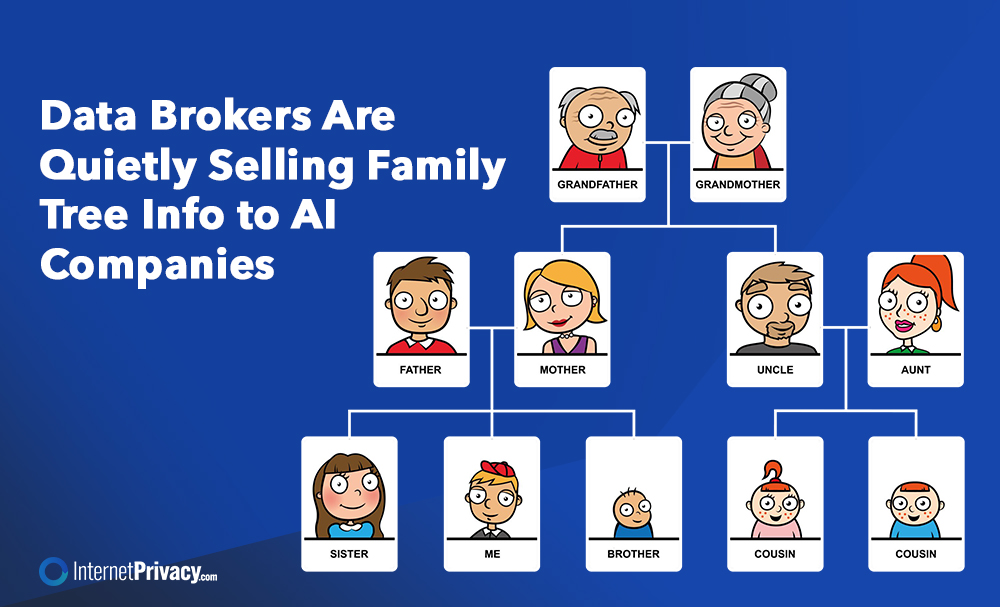Data Brokers Are Quietly Selling Family Tree Info to AI Companies

It often starts with a search. Maybe you’re curious about your last name, or a family story from one of your grandparents. You type in a few details—perhaps a birth date, a place, a surname—and your family tree begins to grow with one click.
Many people don’t realize that the journey into discovering family history isn’t limited to curious individuals and their kids. It also draws the attention of data brokers, developers, and AI companies that quietly track, compile, and sell information gathered from genealogy platforms, public records, and social media. While you explore the past, others are watching.
How Family Tree Data Becomes a Product
When you use genealogy services to create a tree, you’re often prompted to add information about your parents, siblings, children, and other family members. You might upload a photo, note dates of birth, or connect your tree with others to find discoveries. This is where things get complicated.
Many of these platforms automatically save what you input. Over time, your single tree may link to multiple trees, creating a dense web of family connections. While meaningful for those seeking to discover their heritage, this network becomes a goldmine for companies specializing in data aggregation.
Behind the scenes, data brokers purchase and repackage family tree information—collected through genealogy services—and sell it to AI companies developing predictive models. Most users are unaware that their shared family history becomes part of a massive, monetized ecosystem, driven by demand for personal insights.
These companies collect billions of data points from users around the world. When people share information to build their trees—sometimes including genetic test results or sensitive details—they may not realize this data can be analyzed, packaged, and sold. AI developers use it to refine algorithms. Marketers use it to create personalized campaigns. Insurers might use it to assess risk. And individuals have little say in how it’s all handled.
The Business of Family
Family history services often operate on a freemium model. Users sign up for free, input their family data, and are later prompted to pay for additional records or support. While this sounds like a fair trade, many platforms share information with third-party partners.
These partners may include research institutions, biotech firms, or life insurance companies. Some users discover this only after a change in the terms of service. What starts as a personal project to review and preserve family stories can become part of a broader surveillance system.
Sometimes, information shared in one tree can be linked with another, even if the two people involved never interacted. The system automatically matches dates, names, and locations across millions of trees, adding new information without direct user input. While this can lead to amazing discoveries, it also opens up questions about consent and control.
The Privacy Risks Few People Consider
Imagine sharing your family’s birth records, marriage details, or information about a long-lost sibling. Now imagine data being used in a completely different context—by an AI system trying to predict behavior, or by an advertising platform aiming to target “people like you.”
The problem isn’t genealogy itself—it’s what happens when the data escapes the hands of those who created it. Many users assume their trees, stories, and records remain within the family or site. But in reality, large-scale data sharing is built into the business model.
And because these sites often connect you to other users’ trees, it’s not just your story at risk. It’s your children’s, your siblings’, your parents’—your entire family. Every new branch can lead to unexpected exposure.
What You Can Do to Protect Your Tree
If you’re already on a genealogy site, review your privacy settings. Some services allow you to opt out of tree linking or external data sharing. You can also watch for updates to the terms of service and save copies of your data locally.
Here are a few steps you can take today:
- Begin with platforms that are transparent about how your data is used.
- Regularly review what information is visible to others.
- Only connect your tree to trusted family members.
- Use caution when uploading documents or photos tied to living persons.
- Take note of which services offer free access, and which are using that access to build products.
Finally, talk to your family about what you’re doing. Let them know what you’re adding, what discoveries you’ve made, and what you’re signing up for. It’s their story too.
Final Thoughts: The Family Tree Is Still Yours
Creating a family tree is a powerful way to connect with your roots. It helps people discover where they came from, honor their parents and children, and make sense of the journey that brought them here. Watching your family tree grow with each new match or name can feel incredibly rewarding.
But behind the scenes, that same growth can come with risk. As family stories become data points, staying informed and cautious is essential. With the right tools, support, and awareness, you can enjoy the process while keeping your story safe.
After all, every tree deserves strong roots and thoughtful care. Even in a world of billions of records and millions of users, your family story should still belong to your family.





